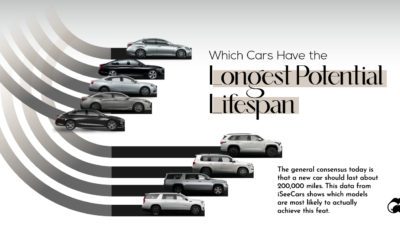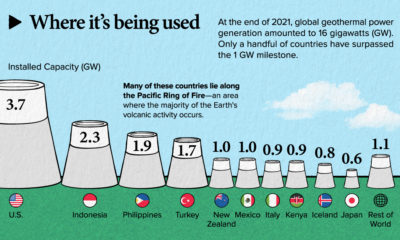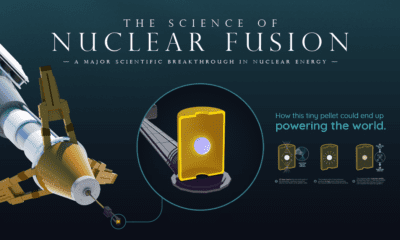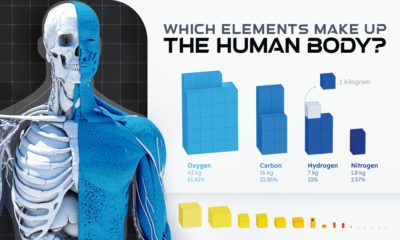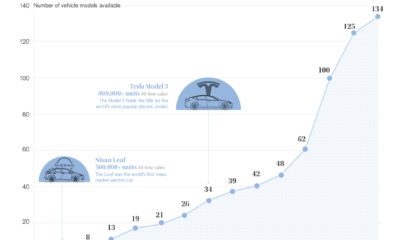The world is looking for alternative ways to ensure the mobility of people and goods with different power sources, and electric vehicles have high potential to fill this need. But did you know that not all electric vehicles produce their electricity in the same way?
Hydrogen: An Alternative Vision for the EV
The world obsesses over battery technology and manufacturers such as Tesla, but there is an alternative fuel that powers rocket ships and is road-ready. Hydrogen is set to become an important fuel in the clean energy mix of the future. Today’s infographic comes from the Canadian Hydrogen and Fuel Cell Association (CHFCA) and it outlines the case for hydrogen.
Hydrogen Supply and Demand
Some scientists have made the argument that it was not hydrogen that caused the infamous Hindenburg to burst into flames. Instead, the powdered aluminum coating of the zeppelin, which provided its silver look, was the culprit. Essentially, the chemical compound coating the dirigibles was a crude form of rocket fuel.
Industry and business have safely used, stored, and transported hydrogen for 50 years, while hydrogen-powered electric vehicles have a proven safety record with over 10 million miles of operation. In fact, hydrogen has several properties that make it safer than fossil fuels:
14 times lighter than air and disperses quickly Flames have low radiant heat Less combustible Non-toxic
Since hydrogen is the most abundant chemical element in the universe, it can be produced almost anywhere with a variety of methods, including from fuels such as natural gas, oil, or coal, and through electrolysis. Fossil fuels can be treated with extreme temperatures to break their hydrocarbon bonds, releasing hydrogen as a byproduct. The latter method uses electricity to split water into hydrogen and oxygen. Both methods produce hydrogen for storage, and later consumption in an electric fuel cell.
Fuel Cell or Battery?
Battery and hydrogen-powered vehicles have the same goal: to reduce the environmental impact from oil consumption. There are two ways to measure the environmental impact of vehicles, from “Well to Wheels” and from “Cradle to Grave”. Well to wheels refers to the total emissions from the production of fuel to its use in everyday life. Meanwhile, cradle to grave includes the vehicle’s production, operation, and eventual destruction. According to one study, both of these measurements show that hydrogen-powered fuel cells significantly reduce greenhouse gas emissions and air pollutants. For every kilometer a hydrogen-powered vehicle drives it produces only 2.7 grams per kilometer (g/km) of carbon dioxide while a battery electric vehicle produces 20 g/km. During everyday use, both options offer zero emissions, high efficiency, an electric drive, and low noise, but hydrogen offers weight-saving advantages that battery-powered vehicles do not. In one comparison, Toyota’s Mirai had a maximum driving range of 312 miles, 41% further than Tesla’s Model 3 220-mile range. The Mirai can refuel in minutes, while the Model 3 has to recharge in 8.5 hours for only a 45% charge at a specially configured quick charge station not widely available. However, the world still lacks the significant infrastructure to make this hydrogen-fueled future possible.
Hydrogen Infrastructure
Large scale production delivers economic amounts of hydrogen. In order to achieve this scale, an extensive infrastructure of pipelines and fueling stations are required. However to build this, the world needs global coordination and action. Countries around the world are laying the foundations for a hydrogen future. In 2017, CEOs from around the word formed the Hydrogen Council with the mission to accelerate the investment in hydrogen. Globally, countries have announced plans to build 2,800 hydrogen refueling stations by 2025. German pipeline operators presented a plan to create a 1,200-kilometer grid by 2030 to transport hydrogen across the country, which would be the world’s largest in planning. Fuel cell technology is road-ready with hydrogen infrastructure rapidly catching up. Hydrogen can deliver the power for a new clear energy era. on Both figures surpassed analyst expectations by a wide margin, and in January, the unemployment rate hit a 53-year low of 3.4%. With the recent release of February’s numbers, unemployment is now reported at a slightly higher 3.6%. A low unemployment rate is a classic sign of a strong economy. However, as this visualization shows, unemployment often reaches a cyclical low point right before a recession materializes.
Reasons for the Trend
In an interview regarding the January jobs data, U.S. Treasury Secretary Janet Yellen made a bold statement: While there’s nothing wrong with this assessment, the trend we’ve highlighted suggests that Yellen may need to backtrack in the near future. So why do recessions tend to begin after unemployment bottoms out?
The Economic Cycle
The economic cycle refers to the economy’s natural tendency to fluctuate between periods of growth and recession. This can be thought of similarly to the four seasons in a year. An economy expands (spring), reaches a peak (summer), begins to contract (fall), then hits a trough (winter). With this in mind, it’s reasonable to assume that a cyclical low in the unemployment rate (peak employment) is simply a sign that the economy has reached a high point.
Monetary Policy
During periods of low unemployment, employers may have a harder time finding workers. This forces them to offer higher wages, which can contribute to inflation. For context, consider the labor shortage that emerged following the COVID-19 pandemic. We can see that U.S. wage growth (represented by a three-month moving average) has climbed substantially, and has held above 6% since March 2022. The Federal Reserve, whose mandate is to ensure price stability, will take measures to prevent inflation from climbing too far. In practice, this involves raising interest rates, which makes borrowing more expensive and dampens economic activity. Companies are less likely to expand, reducing investment and cutting jobs. Consumers, on the other hand, reduce the amount of large purchases they make. Because of these reactions, some believe that aggressive rate hikes by the Fed can either cause a recession, or make them worse. This is supported by recent research, which found that since 1950, central banks have been unable to slow inflation without a recession occurring shortly after.
Politicians Clash With Economists
The Fed has raised interest rates at an unprecedented pace since March 2022 to combat high inflation. More recently, Fed Chairman Jerome Powell warned that interest rates could be raised even higher than originally expected if inflation continues above target. Senator Elizabeth Warren expressed concern that this would cost Americans their jobs, and ultimately, cause a recession. Powell remains committed to bringing down inflation, but with the recent failures of Silicon Valley Bank and Signature Bank, some analysts believe there could be a pause coming in interest rate hikes. Editor’s note: just after publication of this article, it was confirmed that U.S. interest rates were hiked by 25 basis points (bps) by the Federal Reserve.



